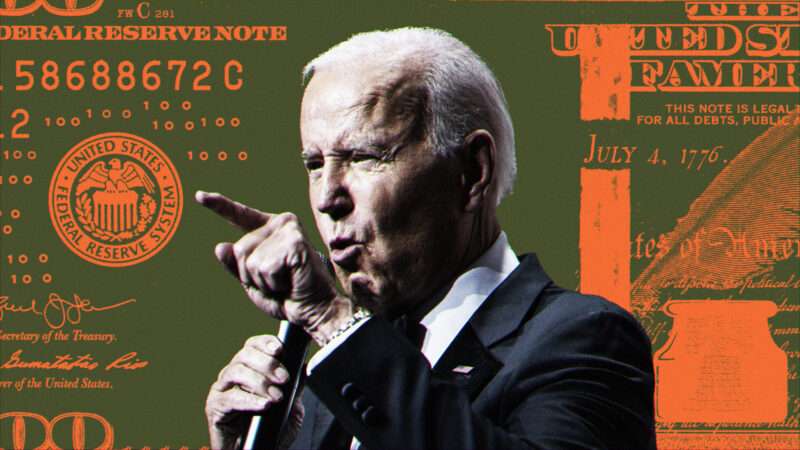
President Joe Biden's sweeping student loan forgiveness plan will wipe all the budget savings created by the Inflation Reduction Act—and then some.
In a letter published on Monday, the Congressional Budget Office (CBO), a nonpartisan federal agency, estimated that Biden's student loan debt forgiveness plan will increase the cost of student loans by $400 billion. That's more than the White House originally projected, and it means that the fiscally imprudent debt relief effort will end up swamping the modest budgetary savings achieved by last month's passage of the Inflation Reduction Act by more than $150 billion.
The letter notes that this cost is calculated by comparing borrowers' "projected repayments of student debt before accounting for the cancellation minus the present value of repayments after doing so." To get the $400 billion estimate, the CBO estimated that 95 percent of borrowers would be eligible for loan forgiveness and 90 percent of eligible borrowers would apply for forgiveness.
Biden's student loan debt forgiveness measures, which were announced last month, would forgive up to $10,000 for most borrowers making under $125,000 annually and married couples making less than $250,000. For borrowers who received a Pell Grant, forgiveness is increased to $20,000.
If anything, the CBO's estimates might lowball the true cost. That's because its estimates do not include possible effects of Biden's reconfiguration of income-driven repayment plans which would set eligibility for repayment at 225 percent of the federal poverty level, limit payments to just 5 percent of borrowers' income, and forgive remaining debt after 10 years of payment. This is a radical change, as most current plans start repayment at 150 percent of the federal poverty level, set payments at 10 percent of a borrower's income, and forgive loans after 20 years of payments.
That's likely why the CBO's estimate of the cost of Biden's student loan forgiveness plan is slightly more conservative than other predictions. The Penn Wharton Budget Model, a fiscal policy think tank housed at the University of Pennsylvania, places the cost of student loan forgiveness at between $469 billion to $519 billion over 10 years.
Penn Wharton also notes that, depending on the precise details of future income-driven repayment plans and increased participation rates, the new income-driven repayment plan could add another $450 billion in cost, bringing the total cost of Biden's plan to over $1 trillion.
Similarly, the Committee for a Responsible Federal Budget announced on Monday that it now estimates that the cost of Biden's plan—including IDR changes—could total between $500 and $650 billion.
If the CBO and Penn Wharton's estimates are correct, then Biden's student loan debt forgiveness plan will effectively wipe out the estimated $238 billion reduction in the national deficit made by the Inflation reduction act. In fact, the plan is likely to massively increase the national deficit by over $150 billion. Student loan forgiveness stands to be a massively expensive project—one that not only erases recent gains in spending reduction but manages to make the problem significantly worse than the status quo.
"As CBO's estimates help confirm, the President's student debt plan would wipe out the ten-year savings from the Inflation Reduction Act twice over, worsen inflationary pressures, and deliver benefits to millions of Americans with advanced degrees in upper-income households," wrote Maya MacGuineas, the president of the Committee for a Responsible Budget. "This might be the most costly executive action in history."
However, Biden administration officials argue that cost estimates for student loan forgiveness are too high. Instead, the White House estimates that the program will cost taxpayers $240 billion over the next decade—assuming that only 75 percent of eligible borrowers participate in the program. The Biden administration is yet to release a detailed explanation of its estimate, though according to USA Today, officials wrote in a memo that "we would be thrilled if 90% of eligible middle- and low-income Americans applied for this program . . . But unfortunately, that's unlikely based on the data from other programs." Notably, no other loan forgiveness programs have gained as much media attention as this latest spate of forgiveness, making an only 75 percent uptake seem unlikely.
Even if the Biden administration is somehow correct and the loan forgiveness plan only ends up costing around $240 billion, the program would still end up negating projected gains from the Inflation Reduction Act. Further, the plan would still leave nothing in place to actually reduce the rate at which Americans are accruing student loan debt—a fact that might "necessitate" further rounds of debt forgiveness in the future.
This latest estimate from the CBO is yet another reason to believe that Biden's student loan forgiveness plan is going to spell fiscal disaster. Not only will the program wipe out possible gains from the Inflation Reduction Act, but it will also go further and increase the deficit by over $150 billion. The real solution to this problem is to create a plan that will actually reduce the amount that students are borrowing to attend college.
Rather than taking the harder, more effective path, the Biden administration seems dead set on taking a ridiculously expensive and ultimately ineffective approach to tackle the student debt crisis.
The post Biden's Student Loan Debt Forgiveness Plan Now Estimated To Cost $400 Billion appeared first on Reason.com.







